The Ultimate Guide to Competitor Tracking 2025
By Emily Fenton
Updated January 8, 2025

Introduction

Gaining a competitive edge is crucial for success. The market is bustling with rivals trying to surpass one another, making it necessary for businesses to continuously understand what the competition is doing in order to try to stay ahead of the curve.
In this post, we’ll cover what competitor tracking is, why it’s important, and some top examples of the kinds of web sources you should track, before jumping into how you can effectively use software tools, like Visualping, to conduct your own competitor tracking.
What is Competitor Tracking?

Competitor tracking is the process of identifying and continuously monitoring your competitors’ products, pricing, sales prospecting, marketing strategies, performance and market positioning. It’s a visual window into your industry as a whole, allowing you to develop competitive intelligence.
The Importance of Competitor Tracking
Monitoring your competition is an important part of the market research process. It can reveal competitor weaknesses in their product offerings or services, giving you an opportunity to use any shortcomings to your advantage. This data can help inform how you can differentiate your brand according to what’s available in the market.
You can also evaluate how their business plans are performing in the market and adapt yours accordingly to learn from their mistakes or successes. With the right data and quality analysis, you can also get important intel that may hint at future intentions.
From marketing initiatives to acquisitions, reviewing changes to this data, over time, can help you gain valuable insights that allow you to make more data-driven choices. You can then position your business to stay ahead of other businesses in your space.
Top Web Sources for Competitor Tracking
- Company Websites: Your rival's own website is a treasure trove of intel. Monitor their homepage, product pages, pricing, and team pages for any changes or updates. Tools like Visualping automate this process.
- Social Media Pages: Follow your competitors on LinkedIn, Twitter, Facebook, and Instagram. Watch for new product announcements, key hires, and customer interactions. Social listening tools can help you track mentions and sentiment.
- News and PR Releases: Set up Google Alerts for your competitor's name and key executives. You'll get notified of any press releases, interviews, or media coverage. This can reveal their marketing strategies and public positioning.
- Review Sites: Monitor sites like G2Crowd, Capterra, and TrustPilot to see what customers are saying about your competitor's products or services. You can spot areas where you excel or need improvement.
- Job Postings or Boards :Check your rival's careers page and job boards like Indeed for new openings
Below are some examples of specific web pages you can track to identify opportunities and threats in the market, and empower you to generate the insights you need to outplay the competition. Monitoring these web sources will help your company become the leader of the pack and capitalize on market share and growth.
You can monitor any of these web sources with Visualping. Visualping is an AI-powered website change monitoring tool that can send you alerts of changes from any web pages online. When a change is detected, you receive an alert that includes an AI summary of the change, distilled in two to three lines, and a screenshot of the page, with the changes highlighted, so you can easily understand the update.
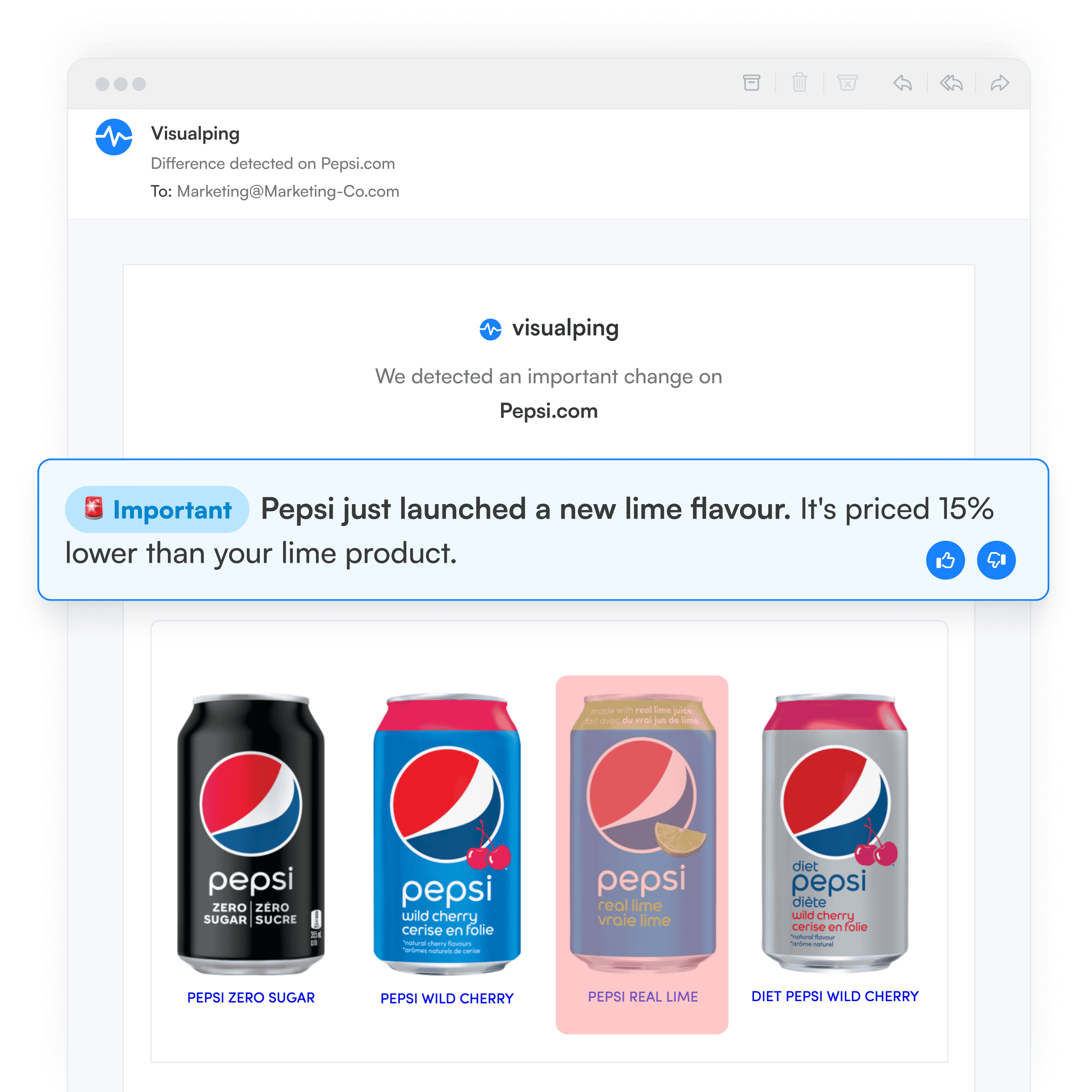
Pricing and Promotions
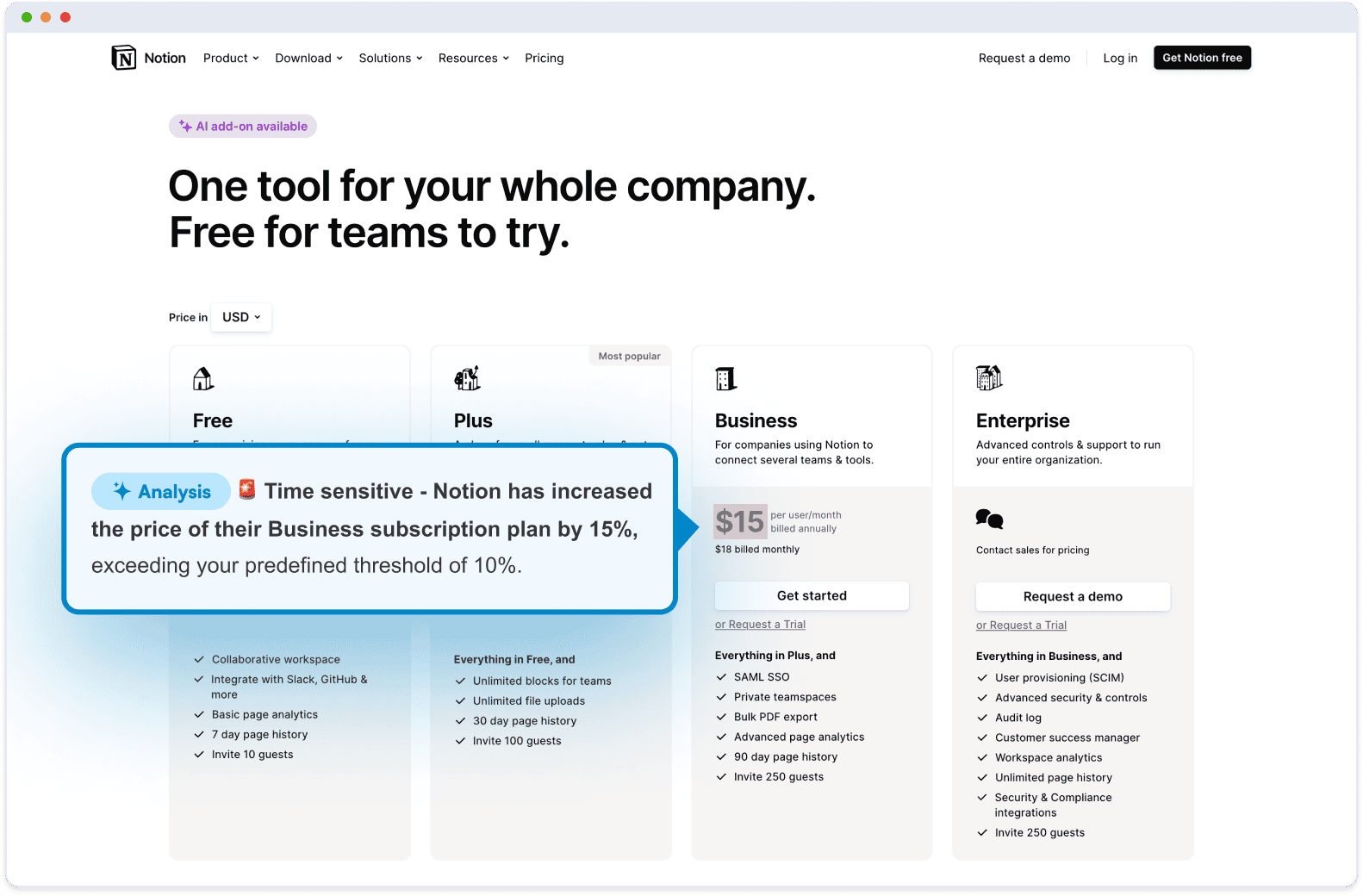
A rival's pricing page is a goldmine. This is especially true in the software industry, where pricing strategies are meticulously crafted and every change signals a significant shift. Here's why you should be watching your competitor's pricing page like a hawk:
- Strategic Insights - Pricing changes can reveal your rival's market positioning, target audience, and perceived value proposition. A sudden price drop may indicate a push for market share. A new enterprise tier could signal a move upmarket.
- Feature Updates - Software pricing pages often showcase key features and benefits. By monitoring this page, you can spot when your competitor adds or removes functionality, giving you a window into their product roadmap.
- Promotional Tactics - Keep an eye out for limited-time offers, discounts, or bundled plans. These promotional strategies can give you ideas for your own marketing campaigns and help you stay competitive.
- Granular Changes - Pricing pages are often dense with details like feature limits, overage charges, and fine print. Manually checking for minor changes can be tedious and time-consuming. That's where automated tools like Visualping come in handy, alerting you to any edits, no matter how small.
Homepage
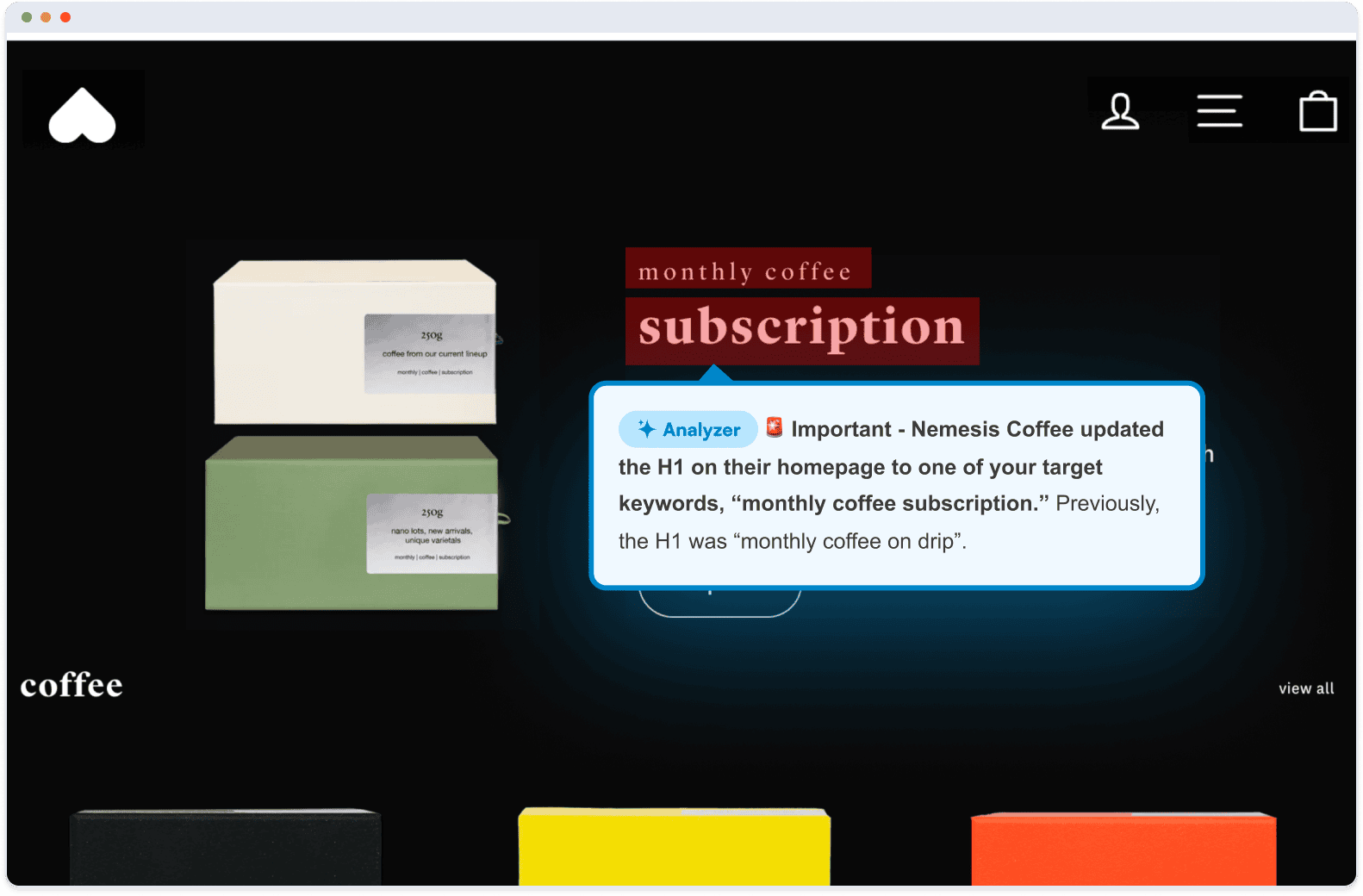
A company's homepage is prime real estate. It's the virtual storefront, the first impression, and the gateway to the brand. Any changes made to this critical page are carefully considered and executed with intent. That's why monitoring your competitor's homepage is a powerful source of competitive intelligence.
By tracking changes to your rival's homepage, you can gain invaluable insights into their strategy and tactics:
- Messaging Shifts - A new headline or tagline can signal a change in your competitor's positioning or target audience. By analyzing their language, you can identify opportunities to differentiate your own messaging.
- Visual Rebranding - Homepage imagery, color schemes, and layout changes often reflect a larger rebranding effort. Staying on top of your competitor's visual identity can help you stay current and competitive in your market.
- Promotional Priorities - Homepage real estate is valuable, so any promotions or special offers featured here are likely high-priority initiatives. By monitoring these promotions, you can gain insight into your rival's sales strategies and product focus.
- Social Proof - Customer testimonials, case studies, and partner logos on a homepage provide a snapshot of your competitor's success and credibility. Tracking changes to these elements can reveal their evolving customer base and industry influence.
Investor Relations and News Pages
For publicly traded competitors (or those owned by public companies), their investor relations section is a goldmine of valuable competitive intelligence. By tracking key pages, you can uncover crucial insights:
- Significant Insider Stock Trades - See when executives and major shareholders buy or sell large amounts of company stock, which may signal their confidence level or knowledge of upcoming events.
- Quarterly Financial Filings - Get alerted instantly when 10-Q and 10-K reports are published. These required SEC filings reveal revenue, profit, growth rates, risks, and forward-looking statements.
- Investor Presentations - Monitor for new investor slide decks which often disclose strategic initiatives, market positioning, and financial projections not found elsewhere.
- Press Releases - Major leadership hires, product launches, M&A activity, and other material news is often announced first in the investor section.
Executive Team Pages
Most businesses showcase their executive team on a dedicated "Meet the Team" page. But this page is more than just a digital yearbook - it's a window into your competitor's strategic priorities and trajectory.
By monitoring your competitor's executive team page, you can spot critical developments:
- Key Hires - When a new C-suite executive or VP appears, it signals where your rival is investing resources. A Chief Innovation Officer could foreshadow ambitious R&D plans. A new regional VP may precede expansion into that geography.
- High-Profile Departures - The sudden disappearance of a longtime executive can speak volumes. It may indicate internal turmoil, a strategy pivot, or an impending restructuring. Departures can create vulnerability - or opportunity.
- Organizational Structure - Subtle changes in executives' titles and reporting lines can reveal evolving competitive focus. A new "GM of Direct-to-Consumer" role shows a push into DTC channels. Consolidating divisions under one leader may preview streamlining efforts.
Sitemap Files
A sitemap is essentially a roadmap of a website, listing all the important pages and helping search engines navigate the site structure. By keeping tabs on your rival's sitemap, you can gain a significant competitive advantage.
Here's how to locate and monitor a competitor's sitemap:
- Find the Robots.txt File: This file is usually located at the root of a website (e.g., www.competitor.com/robots.txt). It contains instructions for search engine crawlers, including the location of the sitemap file.
- Identify the Sitemap URL: In the robots.txt file, look for a line that starts with "Sitemap:" followed by a URL. This is the location of the sitemap file.
- Monitor the Sitemap: Use a website monitoring tool like Visualping to track changes to the sitemap file. You'll get alerted whenever a new page is added, giving you a head start on analyzing your competitor's latest moves.
Some websites have multiple sitemaps organized by content type (e.g., products, blog posts, news articles). If you're lucky enough to find these segmented sitemaps, you can focus your monitoring efforts on the pages that matter most to your competitive strategy.
By leveraging sitemap monitoring, you can:
- Discover new product launches or feature releases before they're widely publicized
- Stay on top of your competitor's content marketing strategy and identify gaps in your own
- Identify shifts in your rival's website structure that could signal a change in priorities or target audience
Why Use Competitor Tracking Tools?

The Perils of Manual Tracking
Manually looking up the information you care about is not a recommended strategy for competitor tracking. Spending time looking it up yourself and manually recording your findings in a spreadsheet is generally considered an inefficient and error-prone process, because doing it yourself opens up the possibility of missing important updates, and making accidental errors.
Especially with the widespread availability of competitor monitoring tools, which automate the research process for you, doing competitor tracking manually is considered time-consuming, ineffective and ultimately more costly than investing in automated competitor tracking that, depending on the tool, can do it better.
But, while investing in software is generally considered the way to go, not all competitive intelligence tools are considered equal.
Most industry standard competitive software have garnered somewhat of a reputation for being expensive and dense with overly complicated and specialized functionalities – most of which your team would not make use of.
And so, when evaluating the many different options out there, it’s important to first identify your team’s goals, and review your options relative to your team’s designated milestones.
Enter Visualping – one of the most popular competitor tracking tools.
It’s more affordable than most industry standard tools, and its methodology is simple: enter the web pages you want to track for updates, and Visualping will notify you of changes. It’s the most suitable monitoring tool for teams looking to keep an eye on specific competitor activity, with the flexibility of getting it from anywhere on the web.
Want to dive deeper into specific Competitor Tracking tools? Check out our Top Competitor Tracking tools post here!
Get Setup with a Competitor Tracker
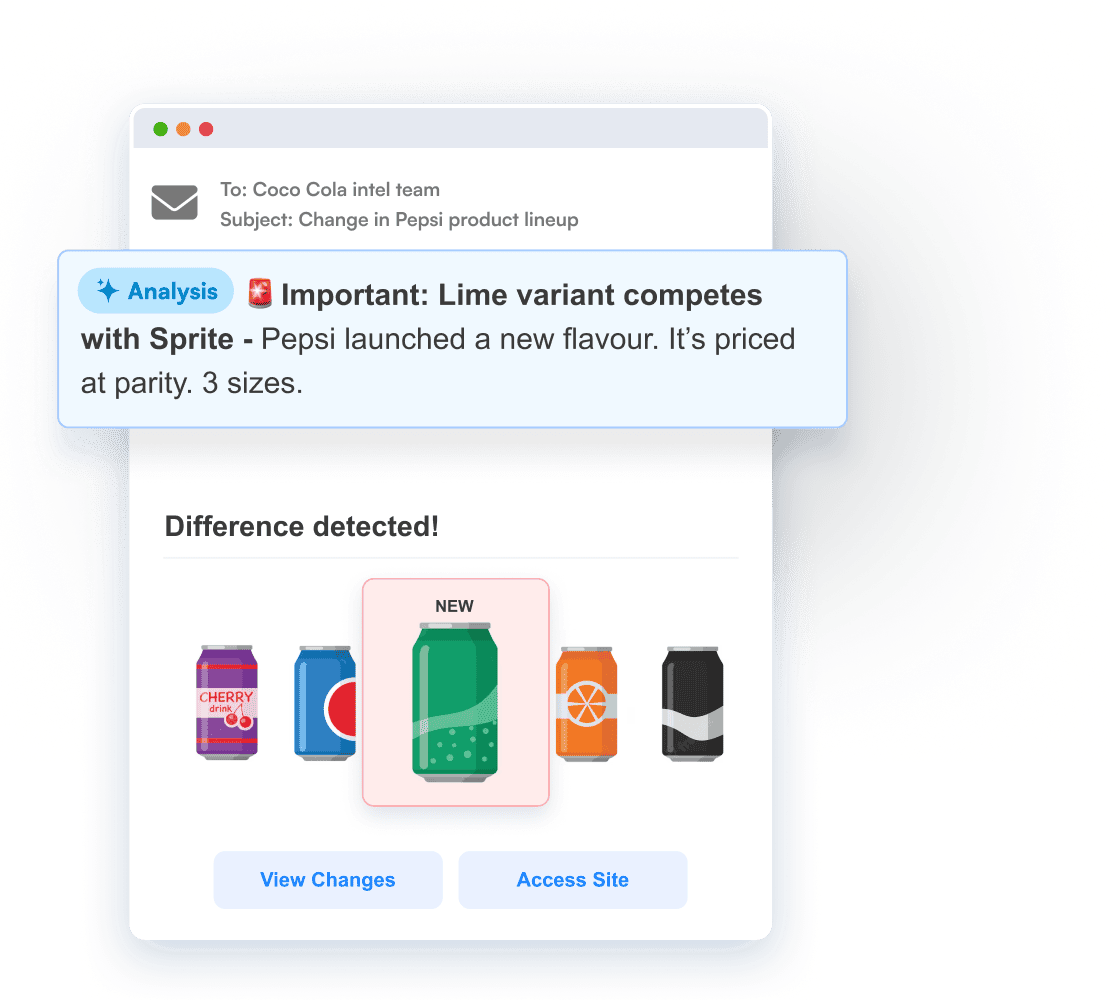
Visualping is a competitor tracking tool that offers a simple and convenient way for staying on top of the exact competitor activity you care about. It can monitor any web pages with AI.
![]()
By automating the process of checking web pages for changes for you, you and your team can save time researching competitor activity. And, by sending alerts when there’s an update, you can more easily keep track of the competitor landscape, and keep your competitive intelligence up-to-date.
For example, you can use Visualping to track competitors' websites for changes – their latest headers and homepage content, promotions and product releases. You can conduct competitor price tracking by getting updates every time your competitor adjusts their prices, and watch for any interesting pricing patterns over time.
Monitor their websites’ sitemap, so that you’ll get notifications every time they make a new page on their site. Or, track the search engine results page (SERP) to keep tabs on how your competitors are ranking, relative to the position of your content.
As you can probably tell, you can use Visualping to monitor whatever it is your competitor strategy calls you to.
Tutorial: How to Use Visualping for Competitor Tracking
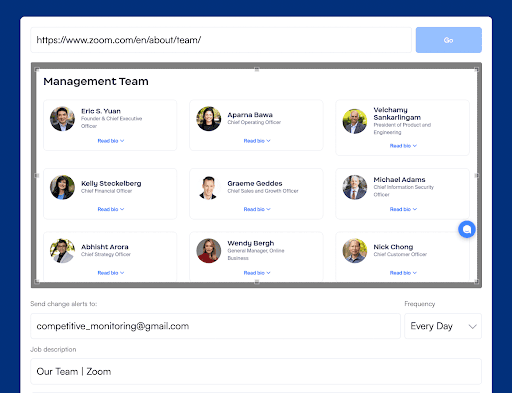
Step 1: Input the URL into Visualping's homepage
To track the competition, open the desired webpage on your browser and copy the URL from the address bar. Then, open up the Visualping homepage and paste the URL into the provided search field.
The web page will appear in Visualping’s viewfinder.
Step 2: Select the Page Section for Monitoring
Next, select the specific area of the page you want to receive updates on. You can select the area, or specific web page elements. Optionally, you can use Visualping’s advanced features to get notified only on certain keywords of interest – if they’re removed or added to the page.
Step 3: Set the Monitoring Frequency
Specify how frequently Visualping should check the page for changes. Adjust the interval based on your preference, ranging from as frequently as every five minutes to as long as every month.
Step 4: Provide Email for Notification Delivery
Next, enter the email address you would like your change alerts sent to.
As a last step, after you click “Start Monitoring”, you will receive an email prompting you to confirm your account – do not skip this! In order to receive alerts on your competitors, you need to confirm your account.
That’s a Wrap!
Get Alerts On the Competitor Data You Need with Visualping
In a competitive market, competitor tracking is the backbone of success. Visualping is the top competitor tracker for efficiently staying on top of your competitor’s activity, so you can make strategic decisions based on up-to-date competitor intel.
Staying ahead of your competitors requires constant vigilance. With Visualping, you can automatically record your rivals, enabling you and your team to analyze the latest updates for insights and make informed decisions.
Interested in finding out more about how your team can use Visualping as a competitor tracker? Contact us today – our support team would be happy to help.
Want to monitor web changes that impact your business?
Sign up with Visualping to get alerted of important updates, from anywhere online.
Emily Fenton
Emily is the Product Marketing Manager at Visualping. She has a degree in English Literature and a Masters in Management. When she’s not researching and writing about all things Visualping, she loves exploring new restaurants, playing guitar and petting her cats.